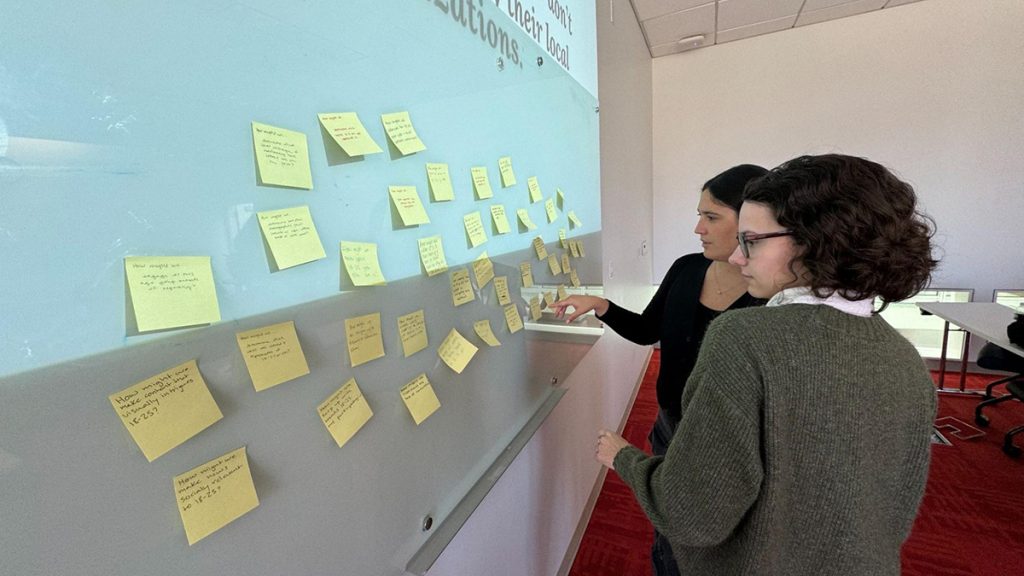
Feli Carrique, Executive Director of the News Product Alliance, and Sydney Lewis, then-senior at the University of Missouri School of Journalism, lead an ideation exercise and training to Mizzou students as part of a partnership between the Reynolds Journalism Institute and NPA.
How to train the next generation of news product thinkers
In order to build strong product thinking into news organizations, journalism needs to nurture the talent of young product thinkers
While it may be an unprecedented time for local journalism, it’s also an exciting one, especially for students who see today’s challenges as opportunities. Young journalists are being exposed to non-traditional journalism roles earlier and earlier, and more are seeing themselves in roles outside of reporting. As one of those students myself, I wanted to explore how the industry can build more concrete paths for students into news product.
Below are the highlights with practical advice, to help newsrooms looking to hire young product thinkers. Here is the full paper.
For local journalism, the stakes have never been higher. Without clear career paths, young, bright product thinkers prepared to lead positive change in local news may be tempted to leave journalism in favor of industries that better recognize, nurture and reward their talent.
The paper explores four keys to building a successful pipeline for a career in product:
- Talent acquisition: Introduction to the discipline of product thinking
- Skill building: Teaching the skills required for product roles
- Applied practice: Gaining experience and applying skills learned
- Career path retention: Providing support to retain talent in the field of news product
These areas represent the potential path from discovering news product opportunities as a student to building a successful career in it. Each section of the paper includes contributions from some of journalism’s major players: newsrooms, support organizations and academic institutions, in addition to important considerations of accessibility and equity.
As we think about expanding opportunities for students to learn about product, it’s important that equity and accessibility are top-of-mind. The current systems for learning about product are not widely available for students of all backgrounds. Building diverse teams starts with delivering equitable and accessible entry points into the field – which newsrooms, universities and support organizations all have a stake in.
Applied practice
Internships and fellowships are the most common way for journalism students to get hands-on, professional experience prior to graduating from college, but product internships are rare in the journalism industry. Some newsrooms offer audience internships, the next closest thing, while many only offer reporting internships.
Newsrooms that have hosted product interns or fellows include:
The Reynolds Journalism Institute (RJI)’s Student Innovation Fellowship program has created product and innovation opportunities for students in newsrooms across the country for many years. Below are examples of work from student fellows of projects undertaken in their fellowship newsrooms:
- Empowering local newsrooms with comprehensive community dashboards
- Making Census data accessible for reporters with varying data literacy
- Maximizing your membership program with product thinking and user research
- Optimize your SEO with service journalism
- How to create and launch an evergreen pop-up newsletter
When building product internships, there are several things to consider. The list below is a cumulation of advice from former product interns and managers of product interns, including Anna Colletto, former RJI Student Innovation Fellow at The Texas Tribune; Emily Hood, former RJI Student Innovation Fellow at the Minneapolis Star Tribune; Sophie Ho, Director of Product and Insights at the News Revenue Hub; Dr. Amanda Bright, Director of the Cox Institute Journalism Innovation Lab; James Tyner, Senior Product Manager at the San Francisco Standard; Nick Petrie, Deputy Digital News Director at Reuters; and Reese Oxner, former Product Manager at The Texas Tribune.
- Give them a project to own, a project to contribute to and a project to observe. This provides at least one complete project to showcase in a portfolio, the opportunity to collaborate with others and the ability to see how a more complicated project works.
- Example: I was an RJI Student Innovation Fellow at NOLA.com | The Times-Picayune. The project I owned was building a pop-up hurricane preparation newsletter. The project I contributed to was launching a daily business newsletter. The project I mostly observed and lightly contributed to was rebuilding newsletter onboarding automations.
- Have a plan for their internship. As an intern, they don’t know your audience or newsroom’s needs. Construct a project that they can take and run with based on their skills and experience.
- Example: Emily Hood’s project of building an analytics Slackbot addressed the newsroom’s need for easily accessible audience data and used her computer science skills.
- Find a balance between skills they have and skills they want to develop. If your intern has any relevant experience, give them a project they can jump in and do and one that will teach them new skills without throwing them in the deep end.
- Don’t give them anything too high stakes. Optimally, assign them a project that is helpful if successful but not detrimental if not. A great place to start is with an internal tool.
- Example: Emily Hood’s analytics Slackbot was a great project because it was newsroom-facing, so the stakes weren’t too high. Yet, she was still able to have a large impact and create a final product to show for her work after a full product design process.
- Involve them in meetings. Bring your intern along to your cross-functional team meetings, revenue meetings, sprint meetings and anything else relevant on your calendar. They can listen and observe or even take notes for you. Debrief with them and help them understand the collaboration necessary for product roles.
- Example: As the product fellow at The Texas Tribune, I sat in on monthly revenue and development meetings where I was purely an observer. Though I didn’t contribute, I soaked up all the information and gained exposure to the business and financial side of the company.
- Ensure your team has capacity for an intern. Your intern will likely not have professional product experience. Not only are you their boss, you’re also a mentor, coach and supporter. If you or someone on the team isn’t prepared to answer questions and walk through challenges with them, your team may not be ready to hire an intern in this space yet.
- Prepare concrete onboarding steps. Give your intern a list of people to schedule 30-minute meetings with in their first week. Help them get acquainted with all of your internal tools, policies and infrastructures.
- Have internal clarity on the skill level you need. Think if you have the capacity to hire someone with no experience and give them the increased attention and support needed to be successful or if you need someone with some experience who can hit the ground running and be a fully contributing member of the team.
- Include the product intern with the rest of the intern cohort. No matter where your product team is situated in your company, your intern should be included in all intern cohort activities. This has an added bonus of teaching the other interns about product and by extension helping to break down silos with other departments.
If you’re facing the challenge of justifying the need for a product internship, here are strategies to help you advocate for the position:
- A product intern can complete a task on your team’s backlog that you haven’t had the time to prioritize but might be relevant to decision makers.
- Even the best-paid interns cost less than hiring a full-time employee.
- Very few product internships exist and this is an opportunity for your newsroom to be a leader in this space.
- Hiring a product intern builds a talent pool for your newsroom to hire from down the line.
Retention
One of the most daunting challenges for graduating product thinkers is the wholly undefined career path in news product. Reporting students can expect to graduate, become a reporter, and progress through their career to become an editor, perhaps making their way to a managing editor or executive editor position. Particularly ambitious reporting students envision themselves as the Editor-in-Chief of a major professional newsroom. Their career path is mostly-linear and has a defined endpoint.
For a collegiate product thinker, where does the road lead? Chief Product Officer, Chief Technology Officer, VP of Product, Director of Product, Product Manager? Organizations have a range of roles and these titles often have different scopes and responsibilities.
Once early career product thinkers get into professional newsrooms, it’s important they see paths forward in their career. This starts with offering more entry-level product jobs and providing internal advancement opportunities within organizations. Transparent expectations and responsibilities for these roles can establish more equitable career development and ensure that opportunities for progression are clear and available to all.
Cite this article
Lewis, Sydney (2024, July 24). How to train the next generation of news product thinkers. Reynolds Journalism Institute. Retrieved from: https://rjionline.org/news/how-to-train-the-next-generation-of-news-product-thinkers/
